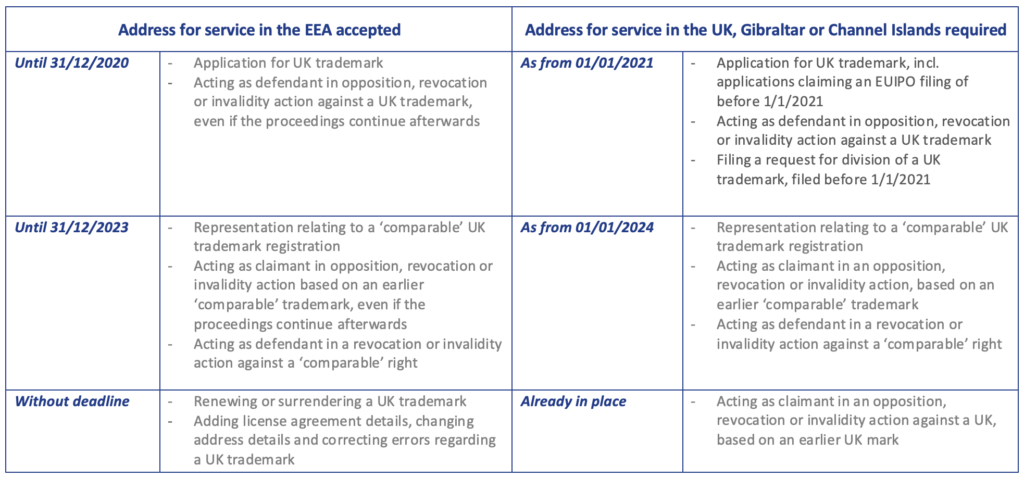Due to the ongoing COVID-19 pandemic, Brexit had the dubious honour of becoming only the second-most important news item of 2020. Fact is nonetheless that 31 December 2020 will mark the official end of the transition period, which followed the UK’s departure from the EU on 31 January 2020.
As a result, European laws and regulations will cease to have effect in the UK. The consequences thereof on IP rights have already been the subject of ample newsletters and webinars.
In this article we will discuss the less explored issue of representation and need for an address for service, both from the point of view of the EUIPO as well as that of the UKIPO. Although the article specifically focuses on trademarks, similar rules apply for designs.
REPRESENTATION BEFORE THE EUIPO
As from 1 January 2021 it will be mandatory for UK companies and citizens to be duly represented before the EUIPO. UK legal practitioners and professional representatives will no longer qualify to represent parties before the EUIPO. This means that on the 1st of January 2021, they will be removed from all files, deleted from the EUIPO’s database of representatives and lose their access to the EUIPO’s user area. There are, however, some exceptions to the foregoing.
First, representation is not mandatory in cases where UK nationals wish to file a new EUTM application.
Second, UK legal practitioners or professional representatives are entitled to continue to represent natural or legal persons before the EUIPO in all stages of the so-called ongoing procedures, initiated before 1 January 2021 and which are still pending after that date.
Finally, employees of UK nationals remain entitled to represent their employer before the EUIPO, insofar as the employee has its place of business or employment in the EEA (Article 119(3) of Regulation no. 2017/1001).
REPRESENTATION/ADDRESS FOR SERVICE BEFORE THE UKIPO
It is useful to recall that EUTMs, registered before 1 January 2021, will be automatically ‘cloned’ into separate national UK trademarks. Although these so-called “comparable trademarks” will be independent rights, they will maintain the same status and filing date as the EUTM from which they were split off. Applications for EUTMs that have not yet matured into registration on 1 January 2021, however, will not be transposed automatically. Here, the applicant has the possibility until 30 September 2021 to refile the trademark in the UK, claiming the same filing details and date of his earlier EUTM application and against payment of the applicable UKIPO fees.
For certain actions, formalities or procedural steps, an address for service in the UK (meaning the UK itself, as well as the Channel Islands and Gibraltar) will be mandatory, whereas for other actions an address for service in the EEA will be accepted. The below table gives an overview of the different situations.

When applying this scheme, it should also be borne in mind that there is a difference between an EUTM and an international trademark designating the EU. Only in the former, the ‘comparable’ trademark right that is created in the UK will have the same details as its EUTM counterpart. The international trademark on the other hand, will be cloned into a national UK registration rather than into a UK designation of the international trademark.
FENCER advises its clients on the possible necessary steps to undertake with respect to their EU and UK portfolios.
If you have any questions, please contact Daphne Vervaet or Stephanie Wuyts.

